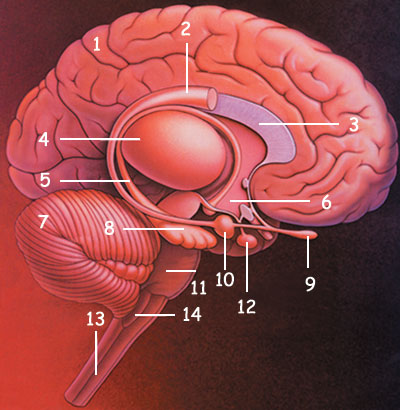 | ||
| 1. Cerebral cortex | 6. Hypothalamus | 11. Pons |
| Most of the information about the human body comes to the hypothalamus. The hypothalamus interprets this information, makes the necessary decisions and causes the cells put these decisions into practice. On the left, we see the position of the hypothalamus in the brain. It is the supreme power of God that enables the hypothalamus to make vital decisions. | ||
The fact that you are able to sit comfortably in your chair and read these sentences is due to systems that organize the internal balance of your body for your benefit. For example, no matter what the temperature outside, your body must always be kept at a constant temperature, usually between 36.5 and 37.5 degrees. A sudden fall or rise in body temperature may result in death. The body temperature of a healthy individual, thanks to these systems, will vary at most 0.5 of a degree. In the same way, the pressure of the blood in the veins, the amount of fluid in the blood, and the speed at which the cells function must be delicately measured, and the existing balance safeguarded at every moment.
Let us imagine the efforts needed to artificially ensure these balances. First, imagine that there exist delicate thermometers in a few places in the body, special devices to measure the density of the blood in the veins, and mini laboratories to control the rate of speed at which the cells function. Then, imagine that all these thousands of tiny devices located in every point in the body must make the right assessments every second and transmit the information they receive to a highly advanced computer.
However, it is not enough that these assessments are made alone; at the same time, it is also necessary to know, according to the available data, which actions must be taken and what kind of command must be given to which cells.
Of course, even with the state of today's technology, it is still impossible to place thousands of thermometers, a mini laboratory, and pressure measuring devices in the depths of the human body. Yet a special system with the finest possible design has been placed from birth deep in the human body.
Thousands of different receivers measure such things as the body's temperature and the pressure in the blood vessels. Then they send this information to a very special computer. This computer is the area of the brain called the hypothalamus.
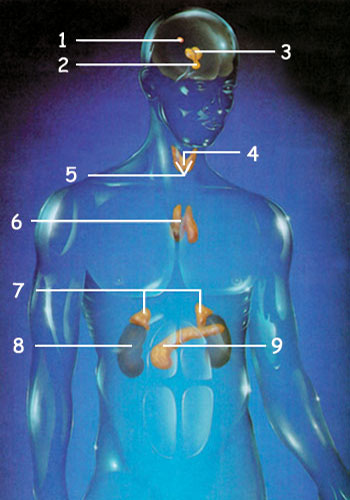 | |
| 1. Pineal gland | 6. Thymus
|
| The location of the hormonal glands under the control of the hypothalamus in the body. | |
The hypothalamus is the general director of the hormone system; it has the vital task of ensuring the internal stability of the human body. At every moment, the hypothalamus assesses messages coming to it from the brain and the depths of the body. Afterwards, it performs a number of functions, such as maintaining a stable body temperature, controlling blood pressure, ensuring a fluid balance, and even proper sleep patterns.
The hypothalamus is located directly under the brain and is the size of a hazel nut. A considerable amount of information relative to the body state is sent to the hypothalamus. Information is transmitted to it from every point in the body, including the sense centers in the brain. It then analyses the information it has received, decides what measures are to be taken, what changes must be made in the body, and causes the appropriate cells of the body to carry out its decisions.
The basic point that must be noticed here is this: the hypothalamus is an organ composed of unconscious cells. A cell does not know how long a human being needs to sleep; it cannot calculate what the body's temperature should be. It cannot make the best decision based on the information at hand, and it cannot make another cell in a far removed area of the body carry out this decision. Yet the cells in the hypothalamus act in an extraordinarily conscious manner to ensure that the necessary balances in the body are maintained. In the pages that follow, we shall examine in detail the remarkable activities displayed by these unconscious cells.
One of the most important functions of the hypothalamus is to form a bridge between the hormonal system and the other system that controls and oversees the body—the nervous system. The hypothalamus not only directs the hormonal system, but also the nervous system with a high degree of expertise.
The hypothalamus has a very important assistant in its role of governing the body; this assistant informs the appropriate body areas of the decisions that have been taken. For example, when there is a drop in blood pressure, bits of information are set into motion, and these inform the hypothalamus of the change in pressure; then the hypothalamus decides what measures must be taken to raise it and informs its assistant of its decision.
In order to effect the decision, the helper knows which cells must receive the command. It writes messages in a language that these cells can understand and transmits them immediately. The cells obey the command they have received and take the appropriate action to raise the blood pressure.
This assistant to the hypothalamus is the pituitary gland, which also has a very important influence on the hormonal system.
Between the hypothalamus and the pituitary gland there is a marvelous system of communication. These two pieces of flesh actually communicate like two conscious human beings. The hypothalamus has complete control over the pituitary gland and its vital secretion of several hormones.
For example, the hypothalamus of a growing child sends a message to the pituitary gland with the command, "secrete the growth hormone" and the pituitary gland then secretes the growth hormone exactly as needed.
Something similar happens when the cells of the body need to work faster; this time there is a two-stage chain of command. The hypothalamus sends an order to the pituitary gland which, in turn, sends the order to the thyroid gland. The thyroid gland secretes the proper amount of thyroid hormone and the cells of the body begin to work faster.
When the adrenal glands (which produce several very important hormones) must be activated or the reproductive organs must produce their hormones, the hypothalamus again sends a message to the pituitary gland, which directs it to the relevant areas and ensures the required hormones in those areas are secreted.
 | |||
| 1. Hypothalamus | 6. Releasing hormones | 10. Prolactin | 15. Milk production |
| The hypothalamus, which is located right under the brain and is the size of a hazel nut, controls many vital functions such as the regulation of the body's metabolism, the operation of the adrenal glands, the production of milk and the regulation of body's growth. While performing these activities, it employs the other hormonal glands under its command. In the illustration above, we see the hormones that work in conjunction with the hypothalamus. The thought that these little pieces of flesh can communicate with each other like conscious human beings and perform their activities concertedly help humans understand the majesty of God. | |||
The hormones produced by the hypothalamus to direct the pituitary gland include:
In some cases the hypothalamus, in order to intervene in the activity of the cells, uses two hormones that it has secreted itself. To store these hormones, it first sends them to the pituitary gland, then, when required, it ensures that they are secreted by the pituitary gland. These hormones are:
These two hormone molecules produced by the hypothalamus are very small. One of them is only three amino acids large. The hypothalamus hormones are distinguished from other hormones not only by being small; they also differ from other hormones by the distance they cover in the body. Hormones generally travel a long distance from the hormonal gland where they were produced to the designated organ. However, the hypothalamus hormones reach the pituitary gland after passing through only a capillary vessel a few millimeters thick. They never enter the general circulatory system.
The hypothalamus produces the hormones that activate the pituitary gland, and when necessary, it also produces hormones that stop the pituitary gland at the appropriate time from secreting a certain hormone. In this way, it has complete control over the activity of the pituitary gland.
 |
The pituitary gland is a small, pink piece of flesh the size of a chickpea, weighing half a gram and connected to the hypothalamus in the brain by a stalk. Thanks to this connection, it takes orders directly from the hypothalamus to produce the required hormones.
This pea-sized pituitary gland has such a great influence on the human body and performs such wonderful functions that it has been the subject of scientific enquiry for years (and still is). This small piece of flesh has won much respect in the scientific world. The pituitary gland has also earned some admiration because of its extraordinary characteristics. For example, the pituitary gland has been called "the conductor of the endocrine (hormone) orchestra." This gland has also been complimented as "the master gland." At the same time, the pituitary gland has been described as an "extraordinary biological wonder."
The pituitary gland deserves these compliments because of the twelve different hormones it produces and the control it exercises over the hormonal system. This gland not only produces hormones that affect particular tissue cells, but also organizes the work of other hormonal glands far distant from it.
If we recall that the hormonal glands are organs that organize the activities of the cells in the body by giving them certain commands, the importance of the pituitary gland becomes all the more apparent. Since the pituitary gland does not stop at giving orders to many cells in the body, it also gives commands to hormonal glands that themselves transmit orders to other cells in the body. In this sense, it functions as a director of directors.
For example, it sends a command to the thyroid gland when conditions require the secretion of the thyroid hormone. In the same way, it issues commands to the adrenal glands, to the testes in the male body, and to the ovaries and the milk glands in the female body.
 |
| 1. Hypothalamus |
| The pituitary gland acts like an orchestra conductor who ensures order in our bodies. |
An important question is:
How do the pituitary gland and the cells which form it know "the function of the adrenal gland," how "it performs its function" and "the sign required to activate it?"
How do the cells that constitute the adrenal gland understand and interpret the command sent to them from the pituitary gland, and why do they obey it?
When we consider the details of the matter, we see that the dimensions of this wonder become even wider. A hormone produced by the pituitary gland is designed to fit on the binding site of the targeted cell. However, no pituitary cell has ever seen the hormonal gland to which a message has been sent. The pituitary cells cannot know the design of the receptors on the cells that compose the adrenal gland. This can be compared to a person who sets out on a journey to a house thousands of kilometers away in another country, who finds himself in front of a door he has never seen, yet has a key that fits the lock at the first try. How do the cells that make up the pituitary gland know how to make the key that fits these locks that they have never seen?
Another important point is that there is no room for error in this system. If the key produced cannot open the targeted door (that is, if the hormone produced does not perform its function in the designated area), death is the result. For example, if the hormone produced by the pituitary gland does not operate on the adrenal gland, the body cannot survive.
In order to understand more fully what a great wonder this system is, we may use the following method: Stand in front of a mirror, place your finger at the point between your two eyes. Five to six centimeters behind this point, right inside your skull, is the piece of flesh, the size of a chickpea, which we call the pituitary gland.
Then, place your other hand on your belly. Just under this hand within the belly area are your kidneys. On top of each kidney there is a gland the size of a walnut weighing about 4-5 grams called the adrenal gland.
Mankind! You are the poor in need of God whereas
God is the Rich Beyond Need,
the Praiseworthy.
(Qur'an, 35: 15)
These two pieces of flesh can communicate between themselves. They are not two conscious human beings conversing with one another, but two groups of cells. Furthermore, this communication system, together with the effects it produces, is the result of an advanced technology that even human beings do not possess.
The fact that two pieces of flesh deep within our body communicate with and understand one another is a wonder to contemplate.
On the other hand, if a person has not studied biology, he is unaware that such an organ exists in his skull just below his brain. Most laymen do not even know that the pituitary gland is a tiny piece of flesh below the brain which keeps us alive by constantly sending messages and ordering commands to the body. Moreover, this person is totally unaware that all these things are happening. If this gland did not perform its function, this person would die after a short time. If you were to look for a moment from this point of view at the person next to you, you would be able to understand more clearly how helpless and dependent human beings are before God, our Creator.
Before going on to consider the names of the pituitary hormones, it is worth repeating that the purpose of this book is to examine those amazing things that happen in the hormonal system that astound even the world of science, and to consider more closely the creative art of God. For this reason, it is better to concentrate on how this system functions, rather than on the names of the hormones. The complex Greek and Latin terms used in medicine and biology are a deterrent for many people. And sometimes these Greek and Latin terms just make the operations of a very simple mechanism more difficult to understand (or to prevent us from appreciating the wonder that occurs in an amazing process). The majority of experts in medicine or biology may not apprehend the wonders that are before them owing to the magic of these words. For example, they know in great detail how the pituitary gland is structured and how it functions, but they never think about the source of the intelligent consciousness that this tiny piece of flesh demonstrates. For this reason, we repeat that it is not necessary to daunt readers unacquainted with medical literature by devoting space to definitions of these terms. We will only briefly mention the names of the hormones and in the following pages we will examine the great wonders of which they are the vehicles.
The pituitary gland is composed of two parts: the anterior and the posterior glands. Each part secretes different hormones.
The anterior pituitary gland secretes six different hormones, whose functions have been determined. Some of these hormones that act on other hormonal glands are called "tropic hormones." They are designed to direct the hormonal system. In the following pages we will examine the functions of the tropic hormones together with the structure and functions of the hormonal glands that they affect. Another group of these hormones stimulate the tissues of the body. The names of these hormones are as follows:
Hormones which stimulate other endocrine (hormone) glands (Tropic Hormones):
Hormones that act on body tissues (Non-tropic hormones)
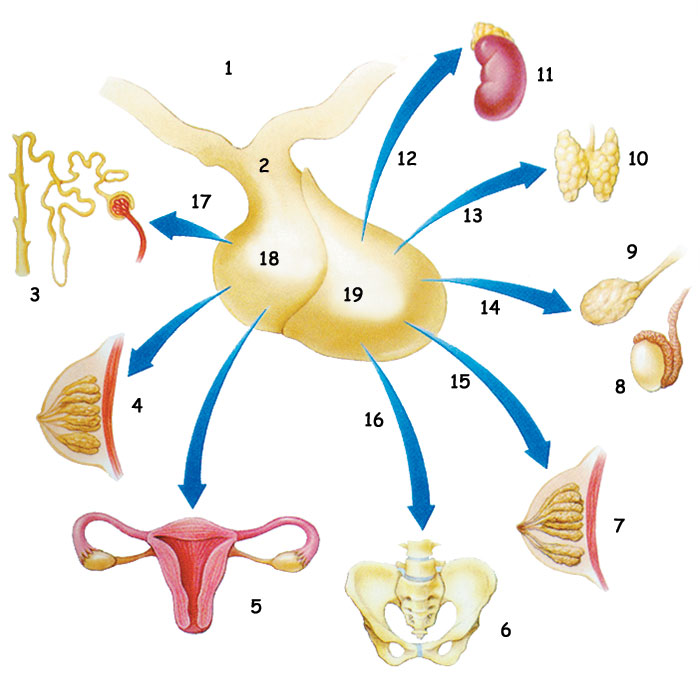 | |||
| 1. Hypothalamus | 6. Bone | 10. Thyroid | 15. Prolactin |
| Commands come continually to all parts of the body from the pituitary gland. By means of these commands, a considerable number of the perfect operations in the body occur. | |||
The posterior section of the pituitary gland is the location where the hormones produced by the hypothalamus are stored. Under the right circumstances, these hormones are secreted by a command from the hypothalamus. These hormones are:
 |
| 1. Heart |
| In the picture at the bottom we see an adult heart. While still in the embryonic stage, a baby's heart develops under the supervision of the growth hormone. In the picture at the top, we see the developing heart that appears as a red nodule. |
A one-year old baby is about twice as heavy and 50% as long as on the day he was born. In one year, he gains weight at an amazing rate. He also grows longer, and his body grows in proportion. What causes a newly born baby who weighs three kilograms and is 50 centimeters long at birth to become a fully grown adult weighing 80 kilograms and measuring 1.80 meters twenty years later?
The answer to this question is hidden in the growth hormone found in an amazing molecule secreted by the pituitary gland.
In order for a baby to become an adult, he must grow. The growing process happens in two different ways. Some cells increase their bulk; other cells divide and multiply. What directs and ensures these two processes is the growth hormone.
The growth hormone is secreted from the pituitary gland and affects all of the cells of the body. Every cell knows the meaning of the message sent to it from the pituitary gland. In compliance with this message, it grows or multiplies.
For example, the heart of a newly born baby is about one-sixteenth the size of an adult heart, yet the total number of cells in the baby's heart is the same as that in the adult heart. As the body develops, the growth hormone affects the heart cells individually. Every cell develops according to the command given to it by the growth hormone. As a result, the heart grows and becomes an adult heart.
 |
| Obeying the growth hormone, our cells construct our faces with perfect balance and symmetry. The cells meticulously obey the command they receive and grow in proportion to one another. Otherwise, the symmetry in the human face would not be possible; if the nose grew too large, the cheekbones may not develop. Or, if the eye grew but the eye sockets did not, the eye would not be able to perform its function. |
The multiplication of the nerve cells stops when the baby is six months old and still lives inside the mother's womb. From this time until birth and from birth to adulthood, the number of nerve cells remains constant. The growth hormone commands the nerve cells to increase in size. When the period of growth of the nervous system has come to an end, it has reached its final form.
Other cells in the body (for example, muscle and bone cells) divide and multiply throughout their period of development. Again, it is the growth hormone that informs the cells how much they must divide.
In the light of these circumstances we must ask this question:
How is it that the pituitary gland knows the correct formula according to which the cells must divide and grow? It is amazing that this piece of flesh, the size of a chickpea, controls all the cells of the body and causes them to grow by dividing or increasing their bulk. Another question that must be asked is: who charged this piece of flesh with this function? Why do these cells throughout their lifetime send messages commanding other cells to divide?
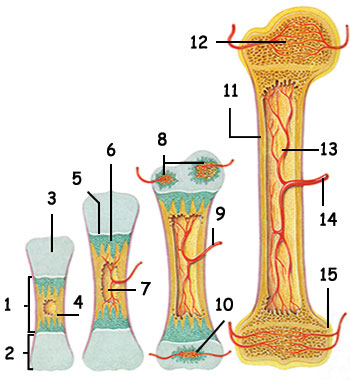 | |
| 1. Diaphysis | 9. Artery |
| Every bone cell in the body knows where it will be, what shape it will have, and how large it will grow. They obey without error the commands they receive from the growth hormone. This communication among its cells allows the body to grow in proportion. | |
Here again we see the flawless excellence of God's creation. Cells located in one small area ensure the orderly division of trillions of other cells. However, it is impossible for these cells to observe the human body from outside to determine how much the body must grow and at which stage it must stop growing. These unconscious cells, in the darkness of the body, without even knowing what they are doing, produce the growth hormone (and cease producing it) when necessary. A perfect system has been created that controls every stage of growth and secretion of this hormone.
It is another wonder that the growth hormones command some cells to increase in size and others to multiply by cell division because the hormones that reach each kind of cell are identical to each other. How the cell that receives the command must react is written in its genetic code. The growth hormone issues the command to grow; how that growth will occur is recorded in the cell. This shows the power and magnificence of creation at every point in the development of the human body.
Yet another very important point is the fact that the growth hormone affects most body cells. If some cells obeyed the growth hormones and others did not, the result would be a disaster. For example, if the heart cells obeyed the commands of the growth hormone but the cells in the rib cage refused to multiply and grow, what would happen? The growing heart would be squeezed in the undersized chest cavity and die.
Or if the bone of the nose grew but the skin on it stopped growing, the bone of the nose would tear the skin and become exposed. The harmonious growth of muscles, bones, skin and other organs is ensured by the obedience of each individual cell to the growth hormone.
The growth hormone also gives the command for the development of cartilage at the ends of the bones.1This cartilage is like the unformed shape of a newly born baby; if it does not grow, the baby cannot grow. The cells in this area cause the bone to grow lengthwise but how do they know that the bone must grow in this way? If this bone grew sideways, the leg would not lengthen; it could even rip the skin and be exposed. But everything is planned and this plan is written in the nucleus of every cell.
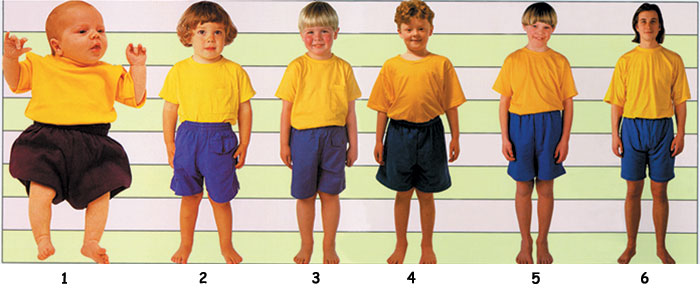 | ||
| 1. 2 months: 1 ft 10 in (55 cm) | 3. 4 years: 3 ft 8 in (110 cm) | 5. 12 years: 4 ft 10 in (145 cm) |
| The growth hormone works like an expert sculptor. Over a period of time, it turns a 50-cm. long baby into fully grown adult of 180 cm. | ||
Another astonishing fact about the growth hormone is when it is secreted and how much. The growth hormones are secreted in exactly the right amount and at the time when the period of growth is most intense. This is very important because, if the amount of hormone secreted were more or less than what is needed, the result would be quite undesirable. If too little hormone is secreted, dwarfism occurs, and if too much is secreted, gigantism is the result.2
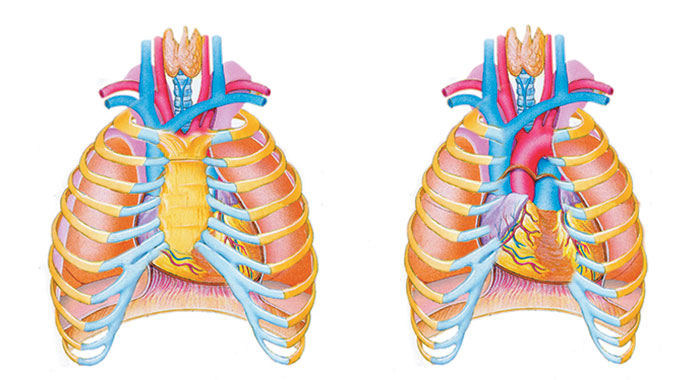 |
| The growth hormone ensures that all of the organs in the body grow proportionately to one another. For example, development of the organs in the abdominal cavity and of the chest cavity is proportionate. If the growth of the chest cavity stopped and the heart continued to develop, the rib cage would crush the heart and cause death. |
So, for this reason a very special system for regulating the amount of this hormone secreted in the body has been created. The amount of this hormone secreted is determined by the hypothalamus, which is recognized as the director of the pituitary gland. When it is time for the growth hormone to be secreted, it sends the "growth hormone-releasing hormone" (GHRH) to the pituitary gland. And when too much growth hormone has been released into the blood, the hypothalamus sends a message (the somatostatin hormone) to the pituitary gland and slows down the secretion of the growth hormone.3
 |
| If a little too much or too little growth hormone is secreted, the results are dynamic. If too little is secreted, dwarfism occurs; if too much, gigantism is the result. For this reason, God has created a special system to regulate the amount of growth hormone secreted. |
How can the unconscious hypothalamus accomplish this task, which seems very difficult even for a human being? How does it measure at every moment the amount of growth hormone in the blood? How does it distinguish the growth hormone from other molecules? These cells do not have eyes to recognize molecules, or brains to evaluate a situation. But they put into effect the commands given to them in perfect a system that God has created.
Yet how do the cells that compose the hypothalamus know how much growth hormone there should be in the blood? How do they measure the amount of growth hormone in the blood and made a decision based on this amount? In order to explain just how great a wonder this is, let us consider an example:
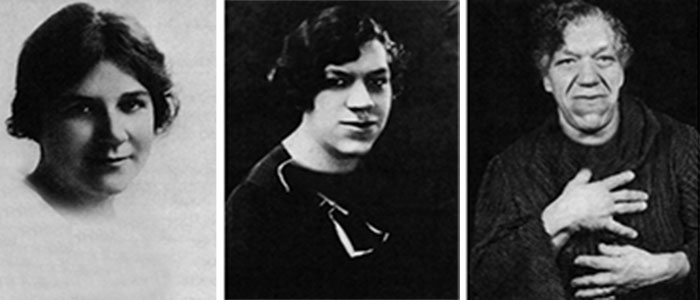 |
| In the above photographs, we see a woman at 16, 33 and 52 years of age who has a condition caused by excessive secretion of growth hormone during adulthood. This condition is characterized by disproportionate growth in the jaw, hands and nose. |
Let us imagine that we have used a special device and reduced a person to several millionths of his original size, that is, to the size of a human cell. We have put him in a special capsule beside one of the cells in the region of the hypothalamus.
The job of this person is to count the number of growth hormone molecules in the capillaries passing in front of him. He determines if there is a reduction or an increase in the number of these molecules. It is well known that there are thousands of different materials contained in the blood. It is impossible for a human being (if he is not an expert in the field) to know from the molecular structure if something in front of him is a growth hormone or something else. But the person we placed in the hypothalamus must recognize with certainty the growth hormones among millions of other molecules. Moreover, he must check the amount of the hormone at all times.
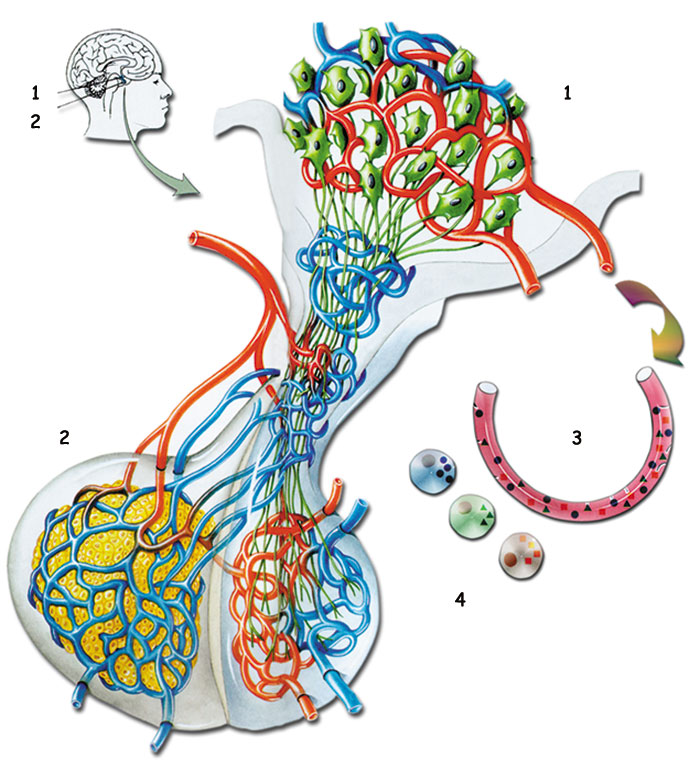 | |
| 1. Hypothalamus | 3. Transport of Hormones |
| It is not possible for us to count the number of growth hormone molecules in our body's capillary vessels or to easily determine a rise or fall in that number. But the cells that make up the hypothalamus select the growth hormone from among the thousands of different materials in the blood and make the required adjustments. | |
The growth hormone is not only secreted in the developmental period but also continues in adulthood. Under these circumstances you would expect that people would continue to grow and become gigantic. But this does not occur.4 When a person reaches a particular size, his cells do not continue to divide and grow. Scientists still do not know why this happens. It is known that thanks to a very special system, cells are programmed not to divide and grow any more after a certain time. Given this situation, a person should think about the Power that created this perfect program. This shows us another wonder of God's creation.
It is not very difficult to understand how important it is that trillions of cells stop dividing and growing together at the correct time. If some of these cells did not stop dividing as others did, the result would be terrible. For example, if the eye cells continued to divide and multiply after the other cell groups have ceased to do so, the eye would be squeezed in its socket and burst.
After speaking about trillions of cells suddenly stopping their activities, there is something else worth remembering. Cancer is a disease that we have been fighting for decades and still have not conquered; it is caused by one single cell continuing to divide out of control. This example permits us to better understand the delicate balance that exists in the body.
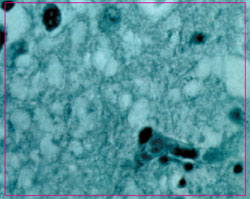 |
| On the left is a picture of a growth hormone. It is too small to be seen with the naked eye but it acts within the body with a high level of consciousness, intelligence and sense of responsibility. It is a wonder how it is able to make a perfectly formed human being. But the One Who actually creates this wonder is God, the Lord of all the worlds. |
In adulthood, the growth hormone continues to have an influence on a few special cells and stimulates these cells to divide and multiply. This is another wonder of creation that serves a special purpose. This cell division no longer causes the body to grow, but serves to repair and regenerate the body. For example, skin cells and red blood cells continue to divide causing our bodies to gain 200 million new cells every minute.5These cells replace old and damaged cells. By this means, the total number of cells remains constant.
The growth hormone has a special design by which it brings several factors into use to ensure cell division and growth.
For cell division and growth to occur, it is first necessary that the cells increase in size, which is possible only through an increase in their amount of protein. So, the growth hormone has a special function in accelerating the production of protein in the cell.
It is known that protein production occurs as the result of a complex process. Scientists have been able to understand only some of the superficial elements in this process after long years of research. In order to produce one molecule to accelerate the operation of this system, it is necessary to know all aspects of it. The fact that the growth hormone has a design that enables it to speed up the production of protein is a proof that the system that produces protein and the growth hormone are created by God to act in harmony with each other and perform their functions according to His command.
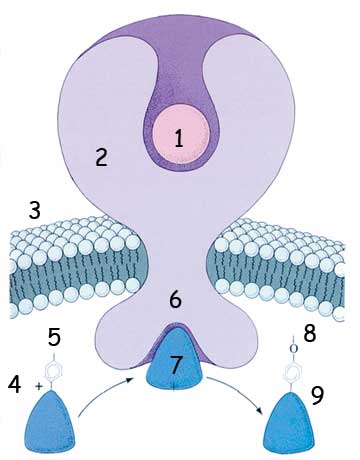 | |
| 1. Growth factor | 6. Tyrosine specific protein kinase domain |
| When the growth hormone reaches the cell, it attaches itself to the appropriate receptor on the membrane. When the receptor is stimulated, the growth hormone begins to perform its function. | |
The growth hormone not only ensures the acceleration of the synthesis of protein, but also ensures that the requisite amount of raw material enters the cells for this purpose. The main material needed for the synthesis of protein is amino acids, the building blocks of protein. As if they were aware of this information, the growth hormone stimulates the cell membrane so that it can receive more amino acids.
In order to speed up the synthesis of protein, the metabolism of the cell must also be accelerated and, to this end, the growth hormone cooperates with other hormones. The thyroid hormone secreted during the period of growth accelerates the metabolic activities of the cells.
In order for all this to happen, one more very important thing is needed: energy. Even if all the systems we have mentioned so far were perfect, they would be of no use without a source of energy. Without energy, the growth process could not occur. But the human body has been so perfectly planned that this need too has been provided for. In addition to all these intricate functions, the growth hormone performs one more very important duty. It ensures the release of fat molecules to mix with the blood. In this way, each molecule will serve as a source of fuel fulfilling the cell's energy needs.
When reading about the activities of the growth hormone in the body, it is important to recall that what accomplishes this is a lifeless, unconscious molecule formed by the combination of a few atoms that have no hands, eyes, or brain. It is remarkable that a lifeless bit of matter can know when and where to go in the body, and when, how and by what means to stimulate it. Unconscious atoms cannot write messages and send them to one another, but this wonderful event happens when some molecules interact with each other. They immediately know what they must do and then do it. For example, when some molecules interact with the growth hormone, they immediately begin to divide. Others decide to take more amino acids. And for this it is only necessary to respond to the growth hormone. How can such a conscious and organized activity continue without interruption in the body?
To claim that all these wonderful balances came to be in the course of time by the operation of chance flies in the face of scientific fact and logic. This is because only one deficiency could destroy the whole system. In order for a living thing to survive, its whole system and all its organs must come to be at the same time. Everything reviewed so far about the growth hormone and these delicate interrelated balances demonstrates the fact that human beings were created perfectly as a complete organism. Concerning the excellence of creation, God says in the Qur'an:
He is God—the Creator, the Maker, the Giver of Form. To Him belong the Most Beautiful Names. Everything in the heavens and Earth glorifies Him. He is the Almighty, the All-Wise. (Qur'an, 59: 24)
This hormone secreted by the pituitary gland stimulates the milk glands in a woman's breast causing the production of mother's milk. This production is under the control of the hypothalamus. How this hormone performs this function will be explained in detail in the section "The wonder of Mother's Milk."
 | |
| 1. Brain | 7. Posterior lobe |
| Oxytocin hormone is produced by the hypothalamus and stored in the posterior pituitary gland. At the correct time, a nerve signal is sent out by the hypothalamus to the pituitary gland causing it to secrete this hormone. Its purpose is to ensure the contraction of the milk channels and uterine muscles when the time of birth approaches. In this way, it facilitates the birth process. | |
This hormone is produced by the hypothalamus and stored in the posterior pituitary gland. It is secreted when necessary by the pituitary gland on receiving a neural stimulation from the hypothalamus. Its functions include contracting the milk channels. Other functions of the oxytocin hormone in the production of mother's milk is treated in detail in the section "The Wonder of Mother's Milk."
In addition to its function in the production of mother's milk, the oxytocin hormone has another duty. It ensures the contraction of the muscles of the uterus at the time of birth to facilitate the birth process. During labor, the production of oxytocin quickly increases. At the same time, the uterine muscle develops a remarkable sensitivity to the oxytocin hormone.6During the birth process, some women are given an injection of oxytocin to help relieve the pain and to speed the birth process.
In order for the production of oxytocin to occur normally, the cells which make up the hypothalamus must be aware of all the elements involved in the birth process that happen a great distance from them. They must know that birth is a difficult process and that they must contract the uterine muscles to push the baby out. Moreover, they must know that a chemical production is necessary for the contraction of the uterine muscles to occur, and they must know the correct formula.
The One Who places the production plan of the oxytocin hormone in the genes of the hypothalamus cells, Who creates the new baby about to come into the world, the mother, the mother's womb, and the hypothalamus cells is God.
The fact that God is the Sovereign of everything that happens in heaven and on Earth, and that everything comes to pass under His supervision is revealed in the Qur'an:
Everyone in the heavens and Earth belongs to Him. All are submissive to Him. It is He Who originated creation and then regenerates it. That is very easy for Him. His is the most exalted designation in the heavens and the Earth. He is the Almighty, the All-Wise. (Qur'an, 30: 26-27)
The nutritional needs of a newly born baby are very different from those of an adult. Because a baby's immune system is weak compared to that of an adult, it is necessary to give it support from outside. The ideal nutrient to respond to all the new baby's needs is mother's milk. Research has shown that breast-fed children are much more healthy and their bodies are better developed.7
Another wonder of mother's milk is that it changes its composition according to the changing needs of the baby at each stage of its development. The huge baby food producers have spent millions of dollars on research trying to determine the ideal mixture of ingredients for a baby's healthy development. So far, they have not found a perfect mixture, but they have determined that a special mixture is needed to meet the requirements of the baby at each stage of its development. In laboratories equipped with the most advanced technology, attempts have been made to produce artificial baby food similar to mother's milk, but no artificial nutrient has yet been developed to take its place.
 |
Here is a real wonder. A few cells in the mother's breast calculate all the needs of a newborn baby in the outside world; that is, the needs of a being they have never before seen or encountered. Then they produce what scientists have never succeeded in producing in the laboratory— mother's milk with its perfect mixture of nutrients. However, the cells that make up the milk glands in the mother's breast are, like other cells, unconscious, without intelligence; yet it is possible for them to calculate the formula needed to produce it.
How does the production of mother's milk begin and how is it controlled? A number of wonders of creation are hidden in the answer to this question. In the production of milk, the hormonal system and the nervous system work in concert and the production occurs after planning based on an exchange of information.
The hormone that activates the milk glands in the mother's breast, as noted, is the prolactin hormone secreted by the pituitary gland. In the early days of pregnancy, certain factors suppress the secretion of prolactin. These factors are like a foot pressing on the brake of an automobile going down a hill. The automobile tends to go downhill, but when the brake is applied, it cannot move. The production of milk is hindered in the mother.
The hindering of prolactin production is very important because, while the baby is still unborn, the milk production in the mother is not needed. How is this brake applied, and how is premature secretion prevented? Here is a true wonder of design. The hypothalamus in the brain secretes a hormone that prevents the production of prolactin. This hormone, called PIH (Prolactin Inhibiting Hormone), slows down the production of prolactin or, in other words, applies the brake.
Who decides to apply the brake? Estrogen, a hormone produced during pregnancy, ensures that the brake is applied by producing PIH. When the baby is born, the amount of estrogen secreted is reduced, which also reduces the amount of PIH. This is like the foot slowly releasing the brake and the car moving down the hill. In this way, the production of prolactin slowly begins and activates the milk glands to produce mother's milk.
 |
1. Where do the cells of the pituitary gland that produce prolactin know the milk glands from? With what conscious intelligence do they give the command to the milk producing cells to produce milk?
2. How do the hormones that prevent the production of prolactin before birth know that the time for milk production has not quite come?
3. How do these hormones learn that prolactin causes the production of milk and that, to prevent the production of milk, the production of prolactin must be inhibited?
Yet another system stimulates the production of mother's milk at the right time; this system is another proof that shows how deliberately the human body is created.
When the baby sucks the milk, nerve cells in the mother's breast send a nerve impulse to the hypothalamus. This impulse affects the hypothalamus and ensures that it removes the brake from the prolactin. In this way, the production of prolactin increases and the milk glands are stimulated for milk production.
From the time of birth, specific receptors are designed in the mother's breast that recognize the baby's sucking reflex. These sensory receptors are connected via neural pathways—similar to electric cables in a building—to another distant organ, the hypothalamus area of the brain. That is, a special system has been created to inform the hypothalamus that the baby's sucking reflex has begun. From among the countless possibilities within the human body composed of flesh and bones, these neural signals travel to the right location. They are not connected by accident to the brain's vision center, the stomach or the intestines; they are connected to exactly the right place, that is, to the hypothalamus.
When this electric signal reaches the hypothalamus cells, they begin the necessary operation for the production of mother's milk. But these cells have no intelligence or consciousness of their own. They cannot possibly know that this signal has come from the mother's breast or that they have been informed of the baby's sucking reflex and, therefore, that mother's milk must be secreted; they cannot know that an important function has been assigned to them in the production of mother's milk, or that they must increase the production of prolactin to activate the milk glands. This being the case, what causes these unconscious cells to engage in this conscious activity?
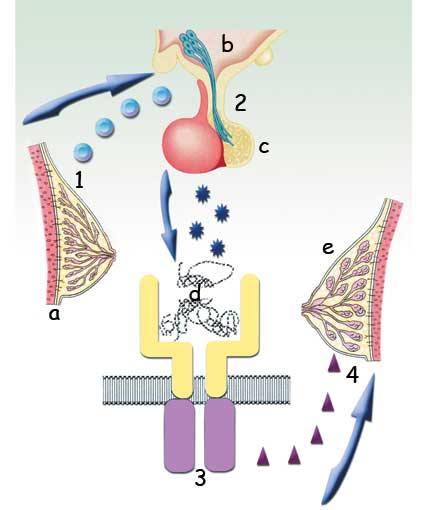 | |
| a-e. Milk glands | c. Pituitary gland |
| 1) When the baby beings to suck, some nerve cells in the mother's beast send a message to the hypothalamus. 2) On receiving the message, the hypothalamus removes the brake from the prolactin. 3-4) In order to begin the production of mother's milk, the prolactin secreted by the pituitary gland stimulates the milk glands in the mother's breast. | |
Who has placed the receptors in the mother's breast?
Who provided the cables to carry the signals sent by these receptors?
Who attached the ends of these cables to the hypothalamus?
Who taught the cells of the hypothalamus that they must stimulate the pituitary gland when these signals come?
Who wrote the formula for activating the milk glands in the cells that make up the pituitary gland?
Who created the circulatory system to ensure that this hormone reaches the mother's breast from the pituitary gland in the brain?
Who created the breast cells in such a way as to become activated when this hormone comes?
Who taught the breast cells the unique formula of mother's milk, a formula which even yet scientists cannot reproduce?
To all these questions there is only one answer: Almighty God, the Lord of all the worlds.
Thanks to scientific and technical advances, it is possible for humans to examine the human body more carefully. This possibility shows the degree of intelligence and planning with which the systems in the human body were created and reveals the creative artistry of God.
For those who reject the existence of God, there is, as always, only one delusion in which they can take refuge—time and chance.
These people accept only chance and the outworking of natural law as the origins of the plan and artistry displayed in living things and in the universe as a whole. But what we have explained above in superficial detail about mother's milk is enough to show the meaninglessness of this claim.
It is scientifically impossible that any one of the thousands of different elements in this system, for example, the breast, the pituitary gland, a nerve or a cell of the hypothalamus or even a single hormone could have come to be by evolution. It is necessary that each element of this system, together with the ancillary systems needed to ensure survival (for example, the circulatory and respiratory systems), come into existence suddenly and at the right location where they are needed to perform their specific functions. Only one explanation exists for this: this system is created by God.
Another proof of creation in the wonder of mother's milk is the oxytocin hormone.
Above we have described the perfect design that exists for the production of mother's milk. But there is a problem: the production of the milk in the milk glands is not sufficient. With his strength alone, the baby cannot suck the milk from the nipple as easily as from a feeding bottle; the milk must travel from the milk glands to the nipple. Otherwise, the system we have described so far will be useless; the mother's milk will not be able to reach nipple from the milk glands and the newborn baby will not receive any nourishment. So, how is the milk made to reach the nipple and the baby?
The countless numbers of people throughout history who have been fed on mother's milk—ourselves included—owe a debt to the oxytocin hormone.
This hormone ensures the contraction of the muscles surrounding the milk channels, moves the milk from the milk glands toward the nipple where it is easily accessible to the baby at breast-feeding time.
Very well. How do the cells that produce the oxytocin hormone know that the milk must reach the mother nipple before it can be used, and that otherwise the baby would not be able to feed? And even if they knew this, how could they know the proper means needed to cause the cells in the milk channels contract?
These are the questions that must be asked by anyone who wants to gain a better understanding of the excellence of this system. The conscious intelligence that is manifested in every cell in the human body bears witness to the eternal knowledge of God Who created them from nothing. In the Qur'an, God reveals that He Himself has ordered everything in heaven and on Earth.
He directs the whole affair from heaven to Earth… (Qur'an, 32: 5)
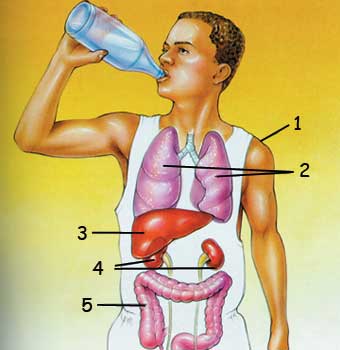 | |
| 1. Skin | 4. Kidneys |
| Water and waste products are expelled from the body through the kidneys, intestines, lungs, liver and skin. | |
Do you know how much fluid there must be in your body to be healthy? Can you calculate how many grams of fluid you take in from the food you eat and the liquids you drink every day? Or can you determine how much of this fluid you must discharge from your body in the same period of time? Can you figure out how many grams of fluid there are in your blood every second of the day, or the level of fluid in your body tissues, or your blood pressure?
If the duty of calculating these numbers were given to each human being, he would be required to devote all his time to this job. This is very important because the human body must be prevented from losing too much fluid. If the fluid loss reached around ten per cent of the body's normal fluid level, death would result.
But a person does not need to measure the amount of fluid in his own body because his body has a system that regulates and orders the fluid level. If you were to examine the details of this system, you would encounter a surprising wonder of engineering and planning.
Loss of body fluid results from sweating or not drinking enough water. If there were no special system in our bodies, no matter how low the density of blood fluids might fall, you would not know it and would eventually die. How is the decrease in the amount of blood fluid sensed and with what measures is it corrected?
There are special sensors in the hypothalamus area of the brain called osmoreceptors. These sensors measure the amount of fluid in your blood at every moment you are alive. If they determine that the amount of fluid in the blood has fallen, they immediately react.
If we substitute a human being in the place of one of these receptors in the hypothalamus, this person would have to measure the amount of fluid in the blood for 24 hours without tiring and without sleeping for all his life. Of course, it is impossible for a human being to carry out such a duty, yet a group of cells devotes its whole life to calculating the amount of fluid in the blood. This shows that this group of cells is performing a function that has been given to it. The hypothalamus does its job under the inspiration of God.
 |
| Water is the compound that the human body needs most. If the body loses only about 10% of its water, it cannot survive. But a person can never measure the amount of water present in his body or take measures to affect it, but his body already has a flawless system to undertake this duty on his behalf. |
Let us assume that the amount of water in blood has dropped. Under this circumstance, what would a human being who was put in the place of these receptor cells have to do? If it were impossible to take a drink of water, how would you raise the amount of fluid in the blood?
If you had no training in biology, it may not enter your mind to purify the water molecules in the urine and send them back to the blood. Even if such an idea came to your mind, you would not know how to achieve this.
At the moment the sensor cells in the hypothalamus detect a fall in the fluid level of the blood, they react with great ingenuity. They make use of a very special messenger hormone (the antidiuretic hormone, ADH) reserved in the pituitary gland. This message is written for the cells surrounding the millions of microscopic tubules in the kidneys. A message is sent to these cells, ordering them to keep back the water molecules in the urine.
At this point, several questions come to mind: How do cells located in the pituitary gland have the intelligence to send orders to kidney cells far distant from themselves and which they have never seen before? How can they write a message that the kidney cells will understand and obey?
Thanks to this communication system, they purify a great number of water molecules in the urine and mix them with the blood again. As a result, the amount of urine is reduced and fluid in the body is restored to a certain level.
In the case that we have drunk too much water, the reverse operation is put into effect. When the fluid level of the blood increases, the sensors in the hypothalamus slow down the release of the ADH hormone. When this happens, the absorption of fluid in the kidneys is decreased. The amount of urine increases and fluid level in the blood is held in balance.
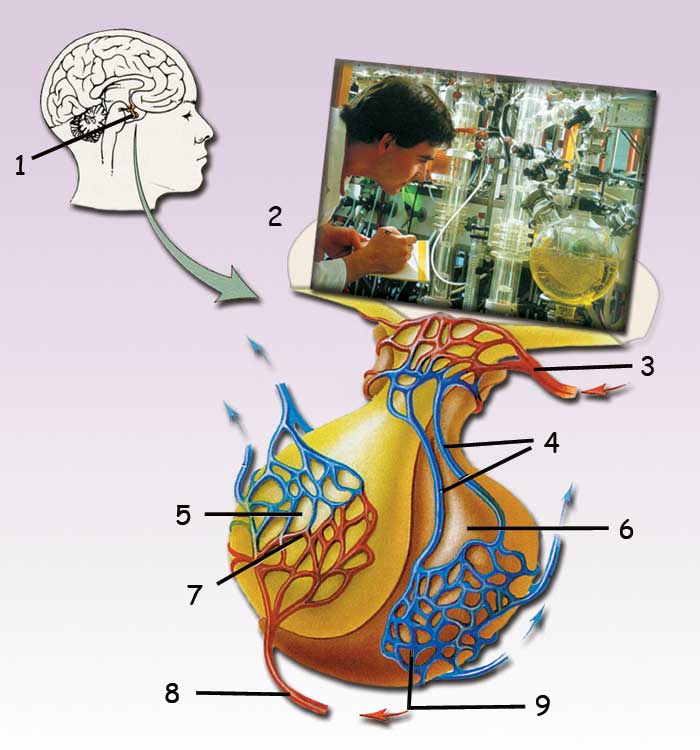 | |
| 1. Pituitary gland | 6. Anterior pituitary gland |
| If it were left to a human being to measure the amount of fluid in his blood and to take measures according to the result, he would need the most advanced laboratory. And he would have to observe what was happening in the blood night and day without taking a break. A human being would encounter countless difficulties in carrying out this duty (if he could even do it), but tiny cells manage it expertly. | |
A characteristic of the ADH hormone is its ability to contract the blood vessels to cause an increase in blood pressure. This is a very well designed security assurance system and another proof of the fact that human beings are specially created. In order for such a security system to function, a comprehensive plan has been put into effect. In the upper chambers of the heart and in the veins coming into the heart, special devices have been placed to measure the pressure of the blood. The cables (nerves) coming from these devices are connected to the pituitary gland. When blood pressure is normal, these devices are stimulated and continuously send electrical impulses to the pituitary gland to prevent the release of the ADH hormone.8
This system resembles an alarm system that uses infrared rays. If a thief unknowingly comes into contact with one of these rays, the connection between a source of light and a receiver is broken and an alarm sounds.
As in this example, when the pituitary receives a signal from the receptors in the heart and veins, it means that all is well.
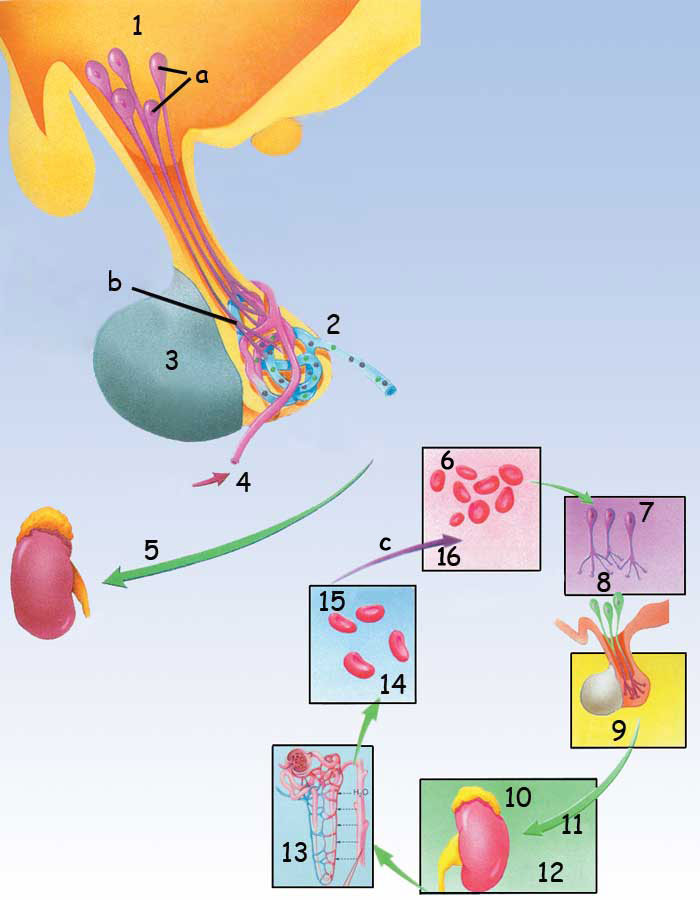 | |||
| a. ADH and oxytocin are produced in neurosecretory cells in the hypothalamus | |||
| 1. Hypothalamus | 5. ADH | 9. Posterior pituitary | 13. Kidney tubules |
| When the level of fluid in the blood falls, a message comes to the hypothalamus. As a result of this, nerve cells in the hypothalamus send a message for ADH to be secreted. The ADH hormone ensures that more fluid will be absorbed back from the kidneys. After the blood is diluted, the secretion of ADH stops. | |||
In the case of heavy bleeding, a person loses a lot of blood, and the amount of blood in the veins decreases. As a result, the blood pressure falls, a very dangerous condition.
When blood pressures falls, the signal sent to the pituitary gland from the receptors in the heart and the veins is broken, causing the pituitary gland to go into a state of alarm and secrete the ADH hormone. The ADH hormone immediately causes the muscles around the veins to contract, thus raising the blood pressure. In order to understand this very complex, interrelated and multifaceted system, a few details are necessary.
 |
| As long as a signal reaches the pituitary gland from the receptors in the heart and blood vessels, everything goes well. But when blood pressure drops, the signal ceases. This causes the pituitary gland to take the required measures. This system resembles an infrared alarm system. As long as the infrared signal continues, there is no problem. But if the signal is interrupted for any reason (as in the picture above), the alarm sounds. |
1. How do the hypothalamus cells, which produce the ADH hormone, know the structure of the cells that surround the veins, cells that are located at a great distance from them?
2. How do they know that these muscles must contract in order for blood pressure to increase?
3. How is it that these cells can produce the chemical formula to bring about this contraction?
4. Where did the neural "transmission cables" of this communication network between the heart and the pituitary gland to produce such a perfect alarm system come from?
Certainly, we have here a real design which shows that human beings did not come into being by the unconscious operation involving chance, but as the result of a perfect act of creation. The evolutionists' claim that the body's communication and alarm system is the result of chance and necessity, that the cells themselves contrived, designed, and constructed this system is contrary to reason. Such a claim is like asserting that a pile of cement, bricks and electrical cable were unloaded on a plot of land and three storms happened: as a result of the first, these building materials formed a skyscraper; after the second, they furnished the skyscraper with an electrical system; and after the third, they put a perfect security system in the building. No one with common sense would accept such an illogical claim. But the evolutionists make even more illogical assertions. Evolutionists, who dogmatically insist on not accepting the existence of God, defend the theory of evolution without considering how contrary to reason their denials are.
However, it is very evident that God exists and that He has created everything in the heavens and on the Earth according to a perfect design:
... Everything in the heavens and Earth belongs to Him. Everything is obedient to Him, the Originator of the heavens and Earth. When He decides on something, He just says to it, "Be!" and it is. (Qur'an, 2: 116-117)
 | |
| Natural events that occur by chance cannot change a pile of cement, bricks and electric cables into a developed city of sky- scrapers (or even a high- ly advanced computer network). | To maintain that the more complex struc- tures in the body are the result of time, nat- ural law, and chance is as senseless as claiming that a city of skyscrapers came to be by the same forces. |
 |
We all have a biological clock within us—this expresses the idea that there are a number of micro-clocks in various regions of our bodies programmed to regulate time. One of these micro-clocks is located in the hypothalamus area of the brain.9
Human beings go through a period of adolescence between childhood and adulthood when the body experiences many definite changes. Girls enter adolescence between the ages of eight and fourteen, boys between the ages of ten and sixteen.
This clock that never goes wrong has been placed in the bodies of the countless human beings that have been created until today. How can this clock understand without error that a person has come into adolescence?
One hypothalamus area of the brain has been waiting for years since the time of birth to perform its very special function. At just the right time, that is, when the time to pass from childhood to adolescence has come, an alarm clock goes off in the hypothalamus. This indicates that the hypothalamus must begin a new job.
Actually, scientists use the comparison to a clock to describe this process in a more understandable way. Of course, there is no clock in the hypothalamus, but comparing it to a clock is the best way to describe how cells wait for years to go into action at just the right time.
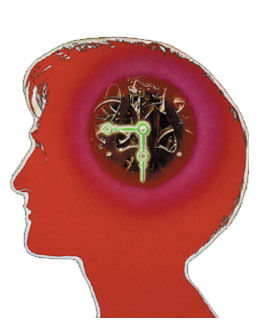 |
| Because of its "hidden" clock, the brain's hypothalamus area "understands" when a person's adolescence has started. And this clock operates in every human being without breaking down or stopping. |
How do the cells that make up the hypothalamus know that the right time has come? The scientific world has not yet been able to explain how a small piece of flesh can act in such a conscious and programmed way.10 It is likely that the details of this system will be understood as years go on, and when they are understood, they will provide another proof of the perfection of God's creation.
With the sounding of the alarm, the hypothalamus secretes the special GnRH hormone. This hormone sends a command to the pituitary gland to secrete two hormones, the Follicle Stimulating Hormone (FSH) and the Luteinizing Hormone (LH).
These two hormones have very special functions and marvelous abilities. Each one begins the process of physical differentiation and development of the male and female body. The FSH and the LH hormones have been designed to effect the areas in which this change will occur and they act as if they knew very well what they have to do.
In the female body, the FSH hormone causes the maturation and development of eggs in the ovaries and ensures the secretion of the very important estrogen hormones by this area.
The FSH hormone is secreted according to the same formula in the male body, but here it has totally different effects; it stimulates the cells in the testes and initiates the production of sperm.
In the female body, the LH hormone ensures that the maturating egg is released and that another hormone called progesterone is secreted.
LH performs a different function in the male body. It stimulates a special group of cells in the testes called the leydig cells and ensures the secretion of testosterone.
It is very interesting to think that these hormones are produced according to the same formula in the bodies of each of the sexes and that in each case the effects are totally different. How do the hormones know the difference between the male and the female body? How does it happen that a hormone composed according to one formula causes the production of testosterone in the male and progesterone in the female? How can hormones of the same formula recognize the male body on the one hand, and ensure the development of the male voice and musculature, and, on the other hand, how can they know the chemistry and special qualities of the female body and make the changes accordingly? Who placed this wonderful genetic program in the cells according to which one hormone has different effects and causes the development of the different sexes?
Who has the intelligence to formulate a plan such as this? Do chance events have such intelligence? Do unconscious cells have it? Or do the atoms that form the cells have it?
It is completely evident that this intelligence does not belong to chance events, to the cell or to the atoms which compose cells. These developments are regulated with a view to the particularities of males and females and show us the existence of a deliberate design and plan. This plan and supreme intelligence belong to God.
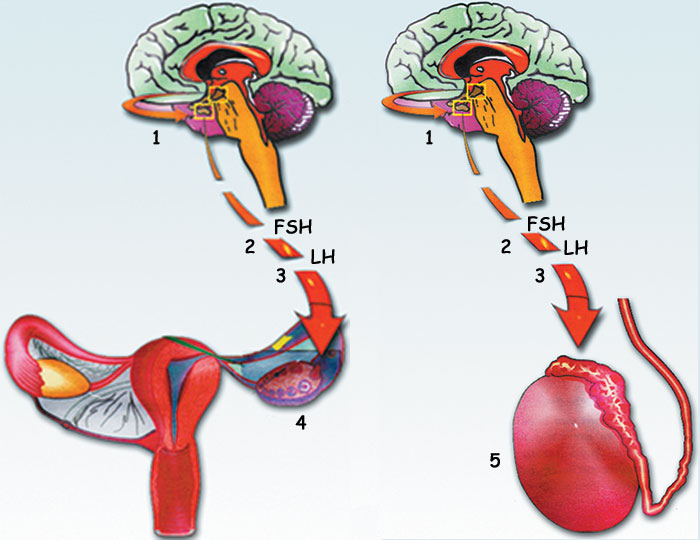 | |
| 1. Pituitary gland | 1. Pituitary gland |
Hormonal Control in Females:LH secreted from the pituitary gland ensures that the egg is released and that progesterone is secreted. FSH ensures the formation and development of egg cells in the ovaries. | Hormonal Control in Males:LH secreted from the pituitary gland stimulates a special group of cells in the testes (leydig cells) and ensures the secretion of testosterone. In men, FSH stimulates the testes cells and initiates sperm production. |
1. The Illustrated Encyclopedia of The Human Body, Marshall Cavendish Books, London, 1974, s. 81
2. Guyton & Hall,Textbbok of Medical Physiology, 7. Baskı, W.B. Saunders, s. 1264-1275
3. Biological Science, A Moleculer Approach BSCS Blue Version-6. Baskı, Colorado 1990, s. 521
4. Glissor S. Linda, Jensen Karen, Lanoutte Edward, Human Machine, Washington D. C. National Geographic Society, 1986, s. 226
5. Glissor S. Linda, Jensen Karen, Lanoutte Edward, Human Machine, s. 222
6. The Illustrated Encyclopedia of The Human Body, s. 81 
7. Biological Science A Moleculer Approach, s. 523
8. Terzioğlu Meliha, Oruç Tülin, Yiğit Günnur, Fizyoloji Ders Kitabı, İstanbul, İ. Ü. Basımevi ve Film Merkezi, 1997 s. 399
9. Body Atlas, Ambrose Video Publishing, Inc. New York, Discovery Communications, 1994
10. Kemalettin Büyüköztürk, İç Hastalıkları, İstanbul, Nobel Tıp Kitapevi, 1992, s 392